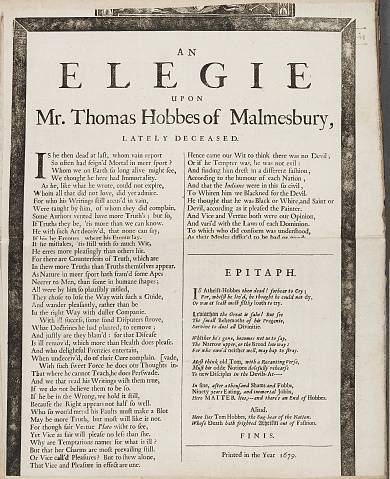Ada Palmer's Blog, page 5
January 11, 2018
From Ada’s AMA: What’s the most effective way for someone today to encourage space exploration?

On 11th January 2018, Ada did a Reddit “Ask Me Anything”. I’m going to be extracting the most interesting of her answers and posting them here. Most of them I’ll be grouping thematically, but this one stands alone.
Injygo: What’s the most effective way for someone today to encourage space exploration and colonization of other planets?
Ada: Probably by passing on aspiration. Our world is saturated with messages telling people to give up, to settle, to take whatever path will make ends meet, to expect to face a grim job market when we reach adulthood, to expect the hours from 9 to 5 to be sacrificed to drudgery, to expect closed doors. When kids are in kindergarten they’re encouraged to say they want to be an astronaut, or a race car driver, or a president when they grow up, but by the time young people reach High School the negative messages have usually won out, that the world is unfair and against them, that dreams are unrealistic, that aspiration is naive, that optimism should be mocked, that cynicism, criticism, and the realism of a pessimistic norm are the smart path. I think the best thing we can do to brighten the future is to stop telling people that it can’t be brightened, that they can’t brighten it. We can all lay down stepping stones in the long road to the stars, but we can lay down exponentially more by telling other people that they can do it too, that they don’t have to waste themselves for the present, that there are a hundred thousand paths open to all of us that let us lay the vital stepping stones.
 I spoke recently with a couple of reps from Oxford and Cambridge universities who work for the programs designed to offer scholarships to underprivelaged students, to help kids raised in poverty have a shot at being anything the want to be. They told me their biggest problem is lack of applicants, that young people in that situation don’t apply. Their worlds are full of messages that telling them that all the doors are already closed, that there’s no path forward, no way out. As one rep put it “The level of aspiration is appalling.” So if we can combat those messages, the messages that kill aspiration, I think that can unlock so many paths forward.
I spoke recently with a couple of reps from Oxford and Cambridge universities who work for the programs designed to offer scholarships to underprivelaged students, to help kids raised in poverty have a shot at being anything the want to be. They told me their biggest problem is lack of applicants, that young people in that situation don’t apply. Their worlds are full of messages that telling them that all the doors are already closed, that there’s no path forward, no way out. As one rep put it “The level of aspiration is appalling.” So if we can combat those messages, the messages that kill aspiration, I think that can unlock so many paths forward.
But, and this is important, I don’t mean just giving empty encouragement. Recently on the phone with my Dad I mentioned that a former undergraduate friend of mine called Angel is now a veterinarian. He cried out in astonishment, “I can’t believe it!” “What?” 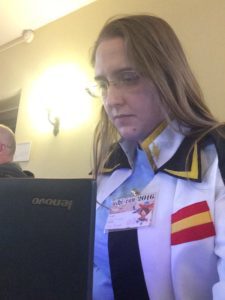 “When you were undergrads you wanted to be a novelist and she wanted to be a vet and you both just did it!” And it’s true, we did, out of so many people who want to be a XXX when they grow up, we really did it. Because we kept that aspiration. And because those around us took that aspiration seriously, and when we told teachers and friends and parents, I want to be an XXX when I grow up, they didn’t say we couldn’t, but they also didn’t just blithely say “Great, go for it!” They helped us plan. They helped us see the steps. You want to be a writer? Okay, you need to do writing exercises, and give hours of training this. You want to be a vet? Okay, you need to take these classes, and look into these schools, and take these steps. You want to be a Renaissance historian? Okay, you need Greek so you need to transfer to a school that has it even though you really like the school you’re at. That’s what kept the door open for me. I think that’s the key, that we need to turn encouragement into a path with concrete steps, whether it’s a path we make for ourselves by looking into what we want, what we need to do to get there, and making a plan, or whether its a path we help make for others. Because all doors are open when we’re little, but as we grow up they close. That’s hard to understand. They close more and faster for some people than others, depending on poverty, race, gender etc., but for everybody some doors stay open and some close. I don’t think we’re very good at teaching young people to understand that. When I was seventeen advisers told me that, if I wanted to be the kind of historian I wanted to be, I had to make a hard choice, leave my college, give up my friend group, to get the Latin and Greek and training I needed to get into a grad school. And because I knew that was a step on the path, I did it. And it hurt, but I’m so glad. And every year I see several dozen applications from students who want to become historians who can’t because they don’t have the languages and background they need to do it well, they didn’t take the right steps at the right time. That door is closed to them. That’s something no one tells you when you’re ten and you want to be an XXX when you grow up. Sometimes people say “Go for it!” and sometimes people say “You’ll never be an XXX, you should be a computer science major so you have a secure job.” But very rarely do people say “That door is open, but it will close if you aren’t careful, so let’s sit down together and work out the steps to get you there.” So I think we need to do that more.
“When you were undergrads you wanted to be a novelist and she wanted to be a vet and you both just did it!” And it’s true, we did, out of so many people who want to be a XXX when they grow up, we really did it. Because we kept that aspiration. And because those around us took that aspiration seriously, and when we told teachers and friends and parents, I want to be an XXX when I grow up, they didn’t say we couldn’t, but they also didn’t just blithely say “Great, go for it!” They helped us plan. They helped us see the steps. You want to be a writer? Okay, you need to do writing exercises, and give hours of training this. You want to be a vet? Okay, you need to take these classes, and look into these schools, and take these steps. You want to be a Renaissance historian? Okay, you need Greek so you need to transfer to a school that has it even though you really like the school you’re at. That’s what kept the door open for me. I think that’s the key, that we need to turn encouragement into a path with concrete steps, whether it’s a path we make for ourselves by looking into what we want, what we need to do to get there, and making a plan, or whether its a path we help make for others. Because all doors are open when we’re little, but as we grow up they close. That’s hard to understand. They close more and faster for some people than others, depending on poverty, race, gender etc., but for everybody some doors stay open and some close. I don’t think we’re very good at teaching young people to understand that. When I was seventeen advisers told me that, if I wanted to be the kind of historian I wanted to be, I had to make a hard choice, leave my college, give up my friend group, to get the Latin and Greek and training I needed to get into a grad school. And because I knew that was a step on the path, I did it. And it hurt, but I’m so glad. And every year I see several dozen applications from students who want to become historians who can’t because they don’t have the languages and background they need to do it well, they didn’t take the right steps at the right time. That door is closed to them. That’s something no one tells you when you’re ten and you want to be an XXX when you grow up. Sometimes people say “Go for it!” and sometimes people say “You’ll never be an XXX, you should be a computer science major so you have a secure job.” But very rarely do people say “That door is open, but it will close if you aren’t careful, so let’s sit down together and work out the steps to get you there.” So I think we need to do that more.
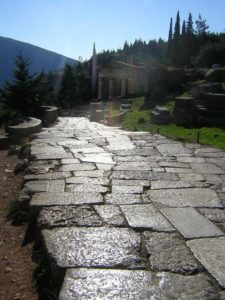 This is mostly advice for how to treat others more than advice for one’s self, because the self is difficult, but no matter what path you’ve ended up on generally you have a few hours you can give to the stars, whether it’s through work or through hobby time, or just through encouraging people. And sometimes, as I say in my song “Somebody Will” we’re already laying those stones, in ways we can’t quite see.
This is mostly advice for how to treat others more than advice for one’s self, because the self is difficult, but no matter what path you’ve ended up on generally you have a few hours you can give to the stars, whether it’s through work or through hobby time, or just through encouraging people. And sometimes, as I say in my song “Somebody Will” we’re already laying those stones, in ways we can’t quite see.
So I think the best thing we can do to lay down stepping stones in the long road to the stars is to tell ourselves and others that we don’t have to waste ourselves toiling for the present, that we are laying the stepping stones. Sometimes we can make that be our work, our vocations, our 9-5, our 40+ hours. Sometimes we can’t do that so it’s an avocation, something we do on the side. Sometimes practicalities of life mean it can’t be more than an attitude, an idea. But it’s all one project, real and succeeding. And Utopia is real already, so long as we keep aspiring to disarm death and touch the stars.
December 19, 2017
The Will to Battle is out today!
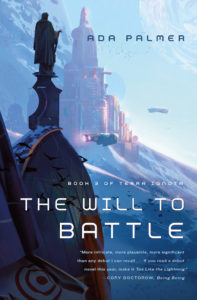 The Will to Battle, volume three of the Terra Ignota series, is released today in the US and UK simultaneously. The audiobook also comes out today. I’m putting up this quick post to let Ex Urbe readers know that it’s out, and rush to get hold of it, and as a place to put links to both reviews and to interviews and guest posts with Ada that might be of interest.
The Will to Battle, volume three of the Terra Ignota series, is released today in the US and UK simultaneously. The audiobook also comes out today. I’m putting up this quick post to let Ex Urbe readers know that it’s out, and rush to get hold of it, and as a place to put links to both reviews and to interviews and guest posts with Ada that might be of interest.
Excerpt from The Will to Battle
Guest blogs, interviews and other places where Ada is talking about The Will to BattleOther Story Ingredients Beyond World, Characters, and Plot
Reviews of The Will to BattleSFF World ReviewRomantic Times Five Star ReviewPublishers Weekly ReviewKirkus reviewBrad Horner reviewBarnes and Noble review
August 12, 2017
Campbell Award & Invisible Disability
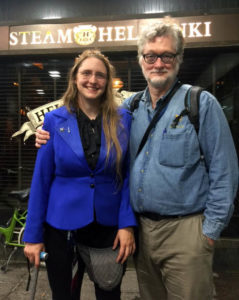
With my wonderful father Doug Palmer after the Hugo ceremony.
Last night I was overjoyed and overwhelmed to receive the John W. Campbell Award for Best New Writer at the Hugo Awards ceremony at Worldcon 75 here in Helsinki, Finland. I was so overwhelmed by this warmest of possible welcomes to the field that I mounted the stage crying too hard to actually read my speech. I also mounted the stage with difficulty, leaning heavily on my cane. Here is a transcription of the speech I ended up giving, which I want to follow with a few comments. I haven’t found a video link but will add one when there is one.
Thank you very much. I have a speech here but I actually can’t see it. I can think of no higher honor than having a welcome like this to this community. This… we all work so hard on other worlds, on creating them, on reading them, and discussing them, and while we do so we’re also working equally hard on this world and making it the best world we possibly can. I have a list with me of people to thank, but I can’t read it. These tears are three quarters joy, but one quarter pain. This speech wasn’t supposed to be about invisible disability, but I’m afraid it really has to be now. I have been living with invisible disability for many years and… and there are very cruel people in the world for which reason I have been for more than ten years not public about this, and I’m terrified to be at this point, but at this point I have to. I also know that there are many many more kind and warm and wonderful people in this world who are part of the team and being excellent people, so, if anyone out there is living with disability or loves someone who has, please never let that make you give up doing what you want or working towards making life more good or making the world a more fabulous place.
I have never discussed my invisible disability in public before, so I want to add a little more detail here for those who must have questions. In my case, the pain comes and goes, often affecting me mildly or not at all, so many of you have seen me singing on stage, or in the classroom, or speaking at a conference with no sign of any pain, but sometimes, as last night, the pain sets in ferociously, too much to hide.
As is often the case with this kind of invisible and intermittent disability, the cause of mine is complicated: for me it’s a combination of Crohn’s Disease (an autoimmune disorder primarily affecting the digestive system), plus P.C.O.S., and some other factors for which I continue to undergo testing. These conditions cause a variety of problems, including inflammation, swelling, and periodic spasms in my lower abdomen. Over the years, this has damaged the muscles of my pelvis. The damaged area can go into spasm at any moment, causing severe pain and difficulty walking, as happened last night. Sometimes the pain is gentle enough that I don’t even notice it. Sometimes it’s medium, so I can walk with a cane and work with effort but get tired easily. Sometimes it is too severe to let me walk or work at all. And once in a while it’s so severe that, without special breathing exercises, I can’t not scream. All medications powerful enough to deal with the stronger forms of the pain also make me extremely sleepy or out-of-it, too much to work, or teach, or give a speech at a Hugo ceremony. So last night, I faced the choice between revealing this to a large public, or turning down the invitation to go receive the honor that means so much to me. So I chose to go to the podium.
I had not discussed this in public before because being public about disability (especially for women) so often results in attacks from the uglier sides of the internet, a dangerous extra stress while I’m working hard to manage my symptoms. I have been open about my disability with my students and colleagues at the University of Chicago, every one of whom has been nothing but outstandingly supportive. In fact, much of the strength which helped me get through last night came from the earlier experience of discussing my disability with my students this past year when I had to explain that I might miss class for surgery. Their outpouring of warmth and support was truly beautiful, but I was also awed by how eager they were to discuss the larger issue of invisible disability, and to hear about how I’ve worked to balance my projects and career with my medical realities, a type of challenge which affects so many of us, and many of them. Thinking of their kindness helped me keep my courage up last night, when having an attack at such a public moment made it impossible to avoid having this same conversation in a much more public and therefore scary space.
I was first diagnosed with Crohn’s Disease in 2004, in the third year of my Ph.D. studies at Harvard. My first attack came suddenly, with no warning signs, on the morning I was supposed to have administered the final exam for one of my very first classes. Thanks to good medical care, and careful control of what I eat, the condition went into remission and was mostly dormant for several years, but it took a bad turn in autumn 2012, and another very bad turn in October 2015, which is when the pelvic damage reached its present level. From October 2015 through June 2017, almost half my days were “pain days,” i.e. days I am in too much pain to do anything but lie down. If I’m strong enough to, I usually watch Shakespeare DVDs, my way of at least doing some primary source research on Renaissance history even when I’m too weak to read or type.
Despite my disability, I have managed, over the past few years, to accomplish many things: publishing award-winning academic articles and my book on Lucretius in the Renaissance, securing a tenure track job at the University of Chicago, composing and recording CDs of my music, and publishing science fiction novels which have now received the warmest welcome to the field I could imagine: the Campbell Award for Best New Writer, the Compton Crook award for best first novel, and finalist for the Hugo Award for Best Novel. But the nasty flare-up that ate so much of 2015-2017 is the real reason that I haven’t posted to this blog much recently, and that the new Sassafrass CD still isn’t done, and that I didn’t do a “blog tour” for the release of my second novel, and that book four Terra Ignota still isn’t done, and that, for the first time, I’ve had to pull out of some academic publications I’d promised to be part of, and turn down invitations that my younger self could never imagine turning down. With more and more opportunities opening before me, one of the hardest parts of living with this disability is learning to say ‘no’ to good and worthwhile things because I need to save those extra days, not for projects, but for pain.
What I have done, what I am doing, I am not doing alone. I have had so many kinds of help from so many people. They were who my speech last night was supposed to be about, because if there is a triumph here, it is the triumph of what can happen when a community of warm, generous people come together. So there was a long list of people I was planning to thank in my speech. I have incredibly supportive parents, Doug and Laura Palmer — thanks to them, I’ve never had to doubt that, when I need help, it will be there. That feeling of safety is invaluable. I also have incredibly supportive housemates Michael Mellas, Lauren Schiller, and Jonathan Sneed, who step up to take care of me when I’m incapacitated, and remind me to take my meds, and often notice before I do when I’m too weak and need to rest, and mean that I never have to push past my limits the way I would if I were alone. I have other friends who’ve helped in so many ways: Carl Engle-Laird, Lila Garrott, Irina Greenman, Jo Walton, and so many more. I have supportive communities: my college science fiction clubs, Double Star at Bryn Mawr and HRSFA at Harvard, my childhood local convention Balticon, and the broader science fiction fan community and filk community. I have the numerous convention staff, liaisons, and friends who have known about my condition for years and been my “spotters” in case I had flare-ups at conventions, and who have kindly honored my request to keep it private. I have colleagues and administrators at my university who instantly rose to the occasion when I brought my condition to their attention, and let me know that if at any time I felt I could no longer handle my teaching duties, they could put things in place to relieve me within 24 hours. I have a team of the best doctors in the world at the University of Chicago Hospitals. (At the risk of making this even more political, I have the larger team who went to bat for America’s health care this year, and preserved the protections without which I could not afford the medications which are finally making my pain days less frequent, and my teaching and writing possible.)
As an author, I’ve had a world class team, too. My agents, Amy Boggs and Cameron McClure, put their all into both disseminating the books and protecting them. My editor, Patrick Nielsen Hayden, always does everything he can to give me the flexibility I need, and his indispensable assistant, Anita Okoye, makes the process run on time. My publicist, Diana Griffin, gets the word out that the book exists, without which it would never reach the readers who are the most important part of all this. My amazing cover artist Victor Mosquera whose covers keep stunning me every time I look at them again. Other friends at Tor and Tor.com help with advice and insights: Miriam Weinberg, Irene Gallo, Teresa Nielsen Hayden. My UK publishing team at Head of Zeus is also fantastic and I can’t wait to do more projects with them.
Nothing means more to me than the opportunity to pay it forward, to build on the immense generosity of everyone who has helped and given me so much, and to give back, through my teaching, my books, my blogging, every conversation, every day. So above all, I want everyone to know that everything I’ve produced, and everything I will produce during my life, living with this condition, is the fruit of the gifts of kindness, large and small, that I have received from so many, many people. Thank you.
July 7, 2017
The Key to the Kingdom, or How I Sold Too Like the Lightning
 I want to share an essay today, one of the most personal things I’ve ever written, and one of those I’m proudest of. It’s about how I sold my first novel.
I want to share an essay today, one of the most personal things I’ve ever written, and one of those I’m proudest of. It’s about how I sold my first novel.
I’ve been stunned since I learned Too Like the Lightning is a finalist for the Best Novel Hugo. This really is the highest honor I can imagine, my work being recognized as one of the most valuable contributions to the community of conversation which drives us forward through speculation about other worlds to touching and creating them, both here on Earth and out among the stars. The community where the Great Conversation thrives. While I always intended to contribute to that conversation, I never expected this kind of reception for a very difficult and intentionally uncomfortable book, one which I had imagined as finding an excited but niche audience, never a large one. I haven’t known what to say other than “Thank you!” but a common “Thank you!” feels mismatched, like paying the same 50¢ at a rock shop for a shiny hematite one week and the Philosopher’s Stone the next. And I’ve also been swamped with final exams, colliding deadlines, three European conferences, research travel, illness, editing book 3, preparing a new project on the History of Censorship (more on that later), all the usual time-eating co-conspirators that make it easy to put off anything difficult. And it is difficult to figure out how to write a world-sized thank-you to match this world-sized joy.
But I think one appropriate thank-you is to share this essay. I wrote it for Shannon Page for her brilliant collection The Usual Path to Publication (Book View Café, 2016), which contains 27 different authors’ stories about how we sold our first novels. The volume’s variety succeeds in showing what it set out to, that there is no “usual path,” no consistent method, no one piece of advice that always helps on the path that no two people ever walk the same way. I suspect I’m not the only contributor to the collection who found that the story that came out, when I tried to tell it, was so personal, so saturated with the most intense emotion, that I was more than a little nervous sharing it at first. But I also think telling the story means even more now that it has a Hugo nomination at the end of it, and a Campbell nomination, and the Tiptree Honors List, and the Compton Crook Award. Because I grew up in Maryland, so I’ve seen the Compton Crook Award given out to a Best First Novel in the genre every year at since I was a little girl, every time thinking “Maybe someday it will be me?” So this is how I got to Someday.
The Key to the Kingdom, or, How I Sold Too Like the Lightning.
by Ada Palmer, 2016
Some people say revenge is living well –
I’ve found it sometimes works to go away
And be more awesome. Let him sit alone,
To watch your wildfires leaping as you play.
-Jo Walton, “Advice to Loki” 2013.
The midpoint first, then the primordial darkness, then the ever after.
It was 2011 (remember, this is the creation myth of a book that won’t come out until 2016). I was in Florence, sitting in the top of a 13th century tower between Dante’s house and my favorite gelato place (extra relevant in an un-air-conditioned August!), and talking to Jo Walton about whether or not I should start a blog. It was the beginning of a year in Florence, a postdoctoral research fellowship at the Villa I Tatti, Harvard’s institute for Italian Renaissance studies. Life as a Renaissance historian had granted me long stays in Florence twice before, once on a student Fulbright, and once taking a shift as I Tatti’s resident grad student mascot (#1 duty, be introduced to rich donors and look bright-eyed and promising). During my earlier stays I had written a series of e-mails describing my Italian experiences, and sent them to a list of friends and family. The list grew over time as the recipients recommended them to more distant cousins and acquaintances, until I had nearly a hundred people on my list. In fact, those e-mails were how I knew Jo. One of my then-roommates, Lila Garrott (a poet, author, book reviewer, and now editor at Strange Horizons) had posted a few of what, in neoclassical style, I called my “Ex Urbe” e-mails on LiveJournal, where Jo had enjoyed them. In 2008 Jo had invited Lila and the rest of our eclectic household to visit her for Farthing Party in Montreal. Jo was with me in Italy that August because the question “Do you want to come stay in my apartment in a 13th century tower in Florence?” has one correct answer. “I wonder if it would be less work to just post them on a blog,” I said, overwhelmed by trying to assemble the new list of people who had asked to receive my e-mails. Jo looked at me very seriously. “If you make a blog, I’ll send the link to Patrick Nielsen Hayden.”
I did make a blog. (This blog.)
In three months, it was in the sidebar of Making Light.
In six months, Patrick asked Jo if the author of this ExUrbe blog had written any fiction.
In two years (almost to the day, August 2013) Patrick bought Too Like the Lightning.
My appetite to see my fiction in print had been overwhelming since elementary school, and I vividly remember the thrill of standing on tiptoe to watch my first typed story (a single paragraph, about blue-and-silver alien raccoons) crawl its way out of the astounding new dot matrix printer at Dad’s office. I had begun a novel by fourth grade, three by tenth, and I devoured summer writing courses, of which the courses on essay writing (Johns Hopkins) and prose poetry (Interlochen) proved far more valuable than the fiction ones. I remember once thinking to myself at fifteen, bored during a school convocation, that if I hadn’t published a novel by twenty-five then… the end is vague. Then I should give up? Then I was a failure? Then I should curse the heavens? It was my first serious college writing mentor Hal Holiday who helped me understand how absurd that was. He made me cry in his office, with my first-ever B on a paper. I didn’t understand what I’d done wrong. “Writing is a long apprenticeship,” he said. I hadn’t done anything wrong, but writing well—not well for your age group, but well in an absolute sense—was hard to achieve. It took real time. Spending every childhood summer and weekend writing, taking every summer writing course, those were good steps, they helped, but they were a beginning. I finished my first novel draft that year, flipped back to page one, and started writing it all over again.
In 2002, at twenty-one and with Mom to stuff the envelopes, I sent my (totally-rewritten) first novel-length manuscript winging its optimistic way to slush piles at agencies and publishers. I sometimes think, if we could harvest the emotional energy in all the fat manila query envelopes aspiring writers entrust to the post office every day, we could move planets. I have a folder of rejection letters from that first volley, and, looking over them now, I can see the good signs in them, the peppering of personalized notes, praise and encouragement among the form letters. I didn’t understand then how many queries editors, agents and interns read, how generous it was for them to sacrifice precious seconds to write these extra lines (thank you!), but it did a lot to keep me going. And in the back of the folder I always kept a printout of Ursula Le Guin sharing a very grim rejection letter she received for The Left Hand of Darkness, with her note “This is included to cheer up anybody who just got a rejection letter. Hang in there!” Thank you. After eight months of agonizing suspense, and the sporadic gut-punch of rejections, that first volley got me an agent. She was not an F&SF specialist, but was game to try, and spent the next years doggedly marketing what neither of us realized was an unsaleably long fantasy novel.
I don’t remember where I received the wisdom that it’s better to go on and write Book 1 of a new series rather than write Book 2 of a series when you haven’t sold Book 1 yet. Wherever I got it from, I obeyed it, and soon my plucky agent was shopping two series, then three. Despite loving to sleep in, I followed the old advice and wrote in the morning, every day, an hour or two, giving my best hours to fiction and the rest of the day to the demands of grad school, and thereby wrote close to a million words of fiction over seven years. Looking over those practice projects now, I can see my writing improve with each, the sentences, the pace, the plot. Every paragraph was a step in that long apprenticeship. The wait stretched on—three years, four—and it hurt—the growing, gnawing appetite. Sometimes I would lie awake at night just from the pain of wanting something so much. But I had an agent, and that gave me confidence, and comfort.
Meanwhile I was working on my Ph.D. The single best thing that ever happened to my writing—looking at the novel I was working on at the time you can see the very chapter break where it happened, like lightning struck and *ZAP!* the prose was finally good—was in 2005, when I had to cut down my 20,000 word dissertation prospectus into a 7,000 word conference paper. Without knowing it, I had stumbled on “Half and Half Again,” as it’s called by people I know in journalism, a training exercise in which you go through the agony of cutting an old work down to half length, then half of that, learning to spot the chaff and bloat in your own work, and how to make it tight and powerful. Lightning. I published other things—my first academic article, blog pieces for Tokyopop about manga & cosplay, a Random Superpower Generator for Maple Leaf Games, but none of them eased the wanting. I also learned more about the world of genre publishing, from going to conventions and chatting with author friends made through Lila, and through my science fiction clubs, HRSFA (the Harvard-Radcliffe Science Fiction Society), and Double Star (at Bryn Mawr College). F&SF specialist agent Donald Maass spoke to us at Vericon, a great little con HRSFA runs at Harvard every year, and I learned from his talk about the field, the extreme oversupply of submissions, the challenges of length and salability. I had queried Donald Maass (unsuccessfully) way back in 2002, but in 2006, with my writing much improved, preparing to begin a new series which I felt in my gut was leap above the others (and eventually became the Terra Ignota series), I decided to break off my relationship with my first agent (with much gratitude and good will) and to try fresh to get a new agent at a major F&SF specialist agency.
I finished the first draft of Too Like the Lightning (Book 1 of Terra Ignota) in 2008, my penultimate year of graduate school. Between 2002 and 2008, plump manila envelopes had evolved into instantaneous e-queries, and my generic cover letters had acquired the varnish of name-dropping. I had recommendations from random people in the publishing world (Walter Isaacson, Priscilla Painton) whom I had met through Harvard. And, while my first 2002 volley had showered queries on dozens of doorsteps (many quite inappropriate), I sent Too Like the Lightning to only one press in 2008, my great hope: Tor. The more I learned about the world of genre publishing, the clearer it became that Tor was one of the only (if not the only) press that had the stability and resources to gamble on a big, fat science fiction series (four long books!) by a first time author, books which were dense and highbrow, and totally not similar to anything—trends are a safe investment; oddities are a gamble. Plus, I had an ‘in’. There were people at Tor who were friends of friends, alumni and associates of both Bryn Mawr and Harvard, some of whom knew my Double Star and HRSFA connections. (Yes, I tried nepotism for all it was worth, anyone would—I still lay awake at nights, just wanting.)
After another year of lying awake and wanting (and finishing my Ph.D., and facing the academic job market, which in 2009 had just entered its sudden death spiral), a Tor contact told me (I think at Readercon?) that the book had advanced from the “slush” pile to the “shows promise” pile. This was good news, but an un-agented manuscript, which the editor knows has been sent to no other press, can stew in that pile forever. That November I queried Donald Maass, hoping a kind word from Tor would help me get an agent, and that a good agent might prod along the literary glacier. I even got a Harvard-made mainstream publishing contact to e-mail Donald Maass with his endorsement to accompany my query. (Roll for nepotism! Did it achieve anything? Not really!) On December 31st, I received an e-mail from Donald apologizing for losing my query and getting back to me so late (apologizing for a delay of only 2 months! Such professionalism! Such sanity!) and saying he loved the beginning of the book, and was eager to read the whole thing. I sent it right away. I waited. I shopped other, older projects with a YA agent recommended by a friend (no luck). I published other things—more academic articles, critical essays, introductions to manga and anime releases. I stayed up nights. Sometimes it was so bad I couldn’t go into a bookstore without feeling sick to my stomach. In November 2010 (a full year after Donald had asked for the book) Amy Boggs, then a fairly new member of the Donald Maass Agency, wrote to say that Donald—swamped by unspecified and mysterious stuff—had passed the book on to her, and she loved it. We finalized the contract by early December, and Amy started shopping the book around in the beginning of 2011.
That spring I received my I Tatti Fellowship, and that summer I sat in a tower in Florence with Jo Walton, contemplating a blog. Jo had talked to me about Patrick Nielsen Hayden, though I also knew of him from other sources; legends of such titans echo far through our little magic kingdom.
There is a fresco by Perugino in the Sistine Chapel, which shows St. Peter, in a beautiful neoclassical square, receiving the Keys to Heaven from Christ, with a group of apostles and others gathered around to watch. It’s a deeply tender moment, Peter’s awe at the sight of the divinity which is also the friend he loves so much. But I can never see it without imagining the next panel of the comic book, where Christ has gone back to Heaven, and Peter is left in the square holding these enormous gold and silver keys, and everyone is standing around awkwardly, trying not to stare, and someone sidles up saying, “So… can I get you a cup of coffee?” You can’t put them down, that’s the thing, once you have the keys to Heaven, no one on Earth can forget it, not for an instant. And that’s very much what it’s like being an acquiring editor (I’ve described this to Patrick, he agrees), because you have the Keys to the Kingdom, and people around you—at conventions, at talks, online—want it so much. So much they lie awake at night. There are infinite horror stories about editors being harassed and chased at cons, having manuscripts shoved under bathroom stall doors, repeated e-mails which get weirder and more desperate. So, from childhood (picture me scrawny and eleven, following Dad and Uncle Bill to a Doctor Who convention, with my boy-short bright blonde hair, dressed as the Peter Davison Doctor) I had it drilled into me that you should never approach and bother an editor (or published author) about your manuscript. Q&A when they were on panels was OK, but outside that sphere verboten! In fact, I had met Patrick at Farthing Party back in 2008, but, knowing who he was, I was an emotional wreck just being near him, racked between the Scylla of my desire and the Charybdis of the taboo, so I spent much of the weekend actively hiding around corners and behind pillars to avoid looking at him. But Jo knew I had a manuscript, and passed it on to Patrick for me in spring of 2012 when he asked her if the author of ExUrbe had written any fiction.
And I waited. And I lay awake at night. On a trip to New Orleans, an editor friend of Jo’s told a story about a query which had taken twelve years to be accepted, which actually made me throw up. I tried to start another novel series, but I couldn’t. Terra Ignota meant too much to me, so I broke my own law and wrote Book 2. And Book 3. So many heartfelt eggs in that basket. Amy had occasional non-news for me, and I was overseeing the publication of my first nonfiction book, the academic history Reading Lucretius in the Renaissance, which will hopefully (knock all the wood you can!) get me tenure here at the magnificent I-dare-you-to-prove-it’s-not-Hogwarts University of Chicago. (Where I teach history of magic. Really.) I had submitted the monograph proposal to Harvard University Press way back in 2009. Given the infamous snail’s pace of academic publishing, I often thought of Reading Lucretius in the Renaissance and Too Like the Lightning as twins fighting to see which would be the first to make it out. But Tor, wonderful, infuriating, experimental, ambitious, field-shaping Tor, is slower.
In March 2013, Jo reported to me that Patrick had said positive things to her about the first page of Too Like the Lightning. One page down, 333 to go. That spring and summer were the madness of producing and recording my two hour close harmony a cappella Viking stage musical Sundown: Whispers of Ragnarok, and its demands were exhaustion enough to let me mostly sleep. As August came along, Patrick told Jo to tell me (in our surrealist game of telephone) that he and Teresa wanted to have dinner with me at Worldcon in San Antonio, and I should have my answer then. This was more than a year after Patrick had asked for the manuscript, and five years after I had first submitted it to Tor.
I was working a booth at that Worldcon, an outreach display for the Texas A&M University Cushing Memorial Library and Archives, which has one of the world’s great science fiction collections, an impregnable treasure vault full of rare pulps, fanzines, first editions, and the archived papers of authors from Star Trek scriptwriters, to George R.R. Martin, to (now) me. (Are you a writer? Do you have random papers and notes from old projects cluttering your house? Cushing’s awesome librarians totally want to take your clutter, index it, and preserve it for posterity! Win-win!). The first morning of Worldcon, I was walking through the dealer’s room on my way to our booth, when Jo Walton gestured me over to the table where she was doing a signing. I gestured back that I didn’t want to interrupt the people who were waiting patiently in line, but she flailed emphatically, so I came. She told me that Patrick told her to tell me “Yes.” I remember hugging, and crying, and intense crying, and gasping out a vague apology to the guy who was in the front of the line, but he said “It’s OK, it’s clearly important.” Jo smiled at him and said, “She’s just sold her first novel!” A keen, satisfied, brightness entered his face, like when you taste an unexpectedly excellent sour candy, and he said, “So, it does happen.”
Most of the rest of the San Antonio Worldcon is lost in the mists of bliss amnesia. I remember staggering back to the Cushing booth all puffy and red-faced, and struggling to communicate to my colleague Todd Samuelson that I was OK, just overhappy from yes! Yes! YES! I remember I couldn’t find my phone to text my dear friend Carl Engle-Laird (a HRSFA alum, who was then a new editorial assistant Tor.com, and sharing my suspense) so I borrowed a phone from Lauren Schiller (my singing partner and roommate of 10+ years), only I couldn’t see through my tears, so the message came out all garbled and full of typos and r5and0m nuMB4rs. I was on a panel right after that, with Lila Garrott (whose online connections had been so instrumental in all this), and I had no time to break the news before the panel, so I just typed it on my then-recovered cell phone and set it on the table in front of us: “Patrick said yes.” Lila glowed.
After Jo’s signing, we found Patrick in the concessions area, and there ensued perhaps the most absurd conversation I shall ever have. I was still paralyzed by the aftereffects of Scylla and Charybdis, so shy and overwhelmed that I could barely force myself to look directly at the legendary Patrick. But Patrick is himself a naturally shy person, and skittish after so many years carrying the Keys to Heaven, so he couldn’t look at me either. And there we were, both trying to hide behind Jo (who is a head shorter than both of us), unable to make eye contact while trying to talk about how we wanted to work together for the rest of our careers. That was when I started to see the absurd flip side of it: all the while that I had been terrified of approaching this incredibly important editor who had power over everything I ever wanted, in his world I had been the intimidating one, this distant Harvard Ph.D., with all these impressive publications, this learned and authoritative tone on my blog, and I had everything he wanted, great science fiction that it would be a pleasure to publish. In Settlers of Catan terms, I had bricks, he had wood, but we were so mutually overwhelmed neither of us could get the words out: “Shall we make this road?” We had dinner with Jo and Teresa at one of those Brazilian Barbeque places, where they hunt the great beasts of the plains and serve them to you on spits carried by excessively statuesque young men—at least that’s what Jo says, because bliss amnesia has erased everything except a vague memory of asparagus and a beige tablecloth. I remember Patrick said he and Teresa wanted to audition to edit and shape my career. Audition? I would have begged!
Patrick took me to the Tor party that weekend. I know he introduced me to Tom Doherty and fifty other genre VIPs, but I genuinely don’t remember a thing except recognizing Liz Gorinsky from a distance by her hair. Patrick forgot to give me his business card, so I almost left without the ability to contact him. It took three weeks to stop feeling like a dream. No, that’s not true—it still feels like a dream. I signed the four book contract by crackling firelight, huddling over the hearthstone during the power outage caused by a New Year’s blizzard, which absolutely feels like a dream. I have a release date now (that took two years), and cover art (same), and the Advanced Bound Manuscript in front of me (well, a defective ABM missing the last three chapters—oops!), and I have a fantastic recording of Patrick—the Patrick—playing guitar with me while I sing my ode to fandom’s support of space exploration “Somebody Will” (super ultra win condition!). But I still feel prepared to wake up tomorrow, back in my old bedroom, and discover it was all a dream. Maybe there will always be that edge of doubt, the scar of how intensely I worried that the door might never open. Sometimes it doesn’t. But if it did open for me, it wasn’t because I kept pounding on the gate with the same desperate query. And it wasn’t the favor-trading, or the Harvard connections, or my attempts at nepotism, or even (honestly) my agent (though she’s done so many great things for me then and since). It was that I set forth to be more awesome. I kept honing my craft, starting new projects better than the last, producing other works, articles, music, essays, research, the blog. I made my fire burn bright in the dark. People do see.
From The Usual Path to Publication , ed. Shannon Page, Book View Café, 2016.
March 7, 2017
Seven Surrenders is Out: New Links Post
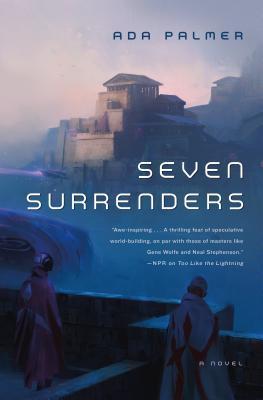 Ada’s second novel, book two of the Terra Ignota quartet, Seven Surrenders, is published today, so at last people who have been waiting since reading Too Like the Lightning last May can read it.
Ada’s second novel, book two of the Terra Ignota quartet, Seven Surrenders, is published today, so at last people who have been waiting since reading Too Like the Lightning last May can read it.
If anyone hates cliffhangers so much that they have been waiting to read Too Like The Lightning until Seven Surrenders came out, you can safely now read both, because there’s a proper pause at the end of Seven Surrenders before the other two volumes. You’ll still really want the other volumes, but it has satisfying volume completion.
The series will be complete in four books. The third book, The Will to Battle, is currently scheduled for December, and Ada is presently writing the fourth and final book.
 Seven Surrenders is available in hardcover and e-book form, and is also now available as an audio-book, narrated by T. Ryder Smith.
Seven Surrenders is available in hardcover and e-book form, and is also now available as an audio-book, narrated by T. Ryder Smith.
Links to interesting and worthwhile reviews, interviews, and blog posts Ada has written about the book will be added to this post — so more links will appear here as time goes on.
There will be a Crooked Timber seminar on Terra Ignota starting this week.
Me Talking About Seven SurrendersWhat the Future Will Call This Era -- Tor/Forge blog
Reviews of Seven SurrendersBarnes and Noble ReviewBrad Horner ReviewGoodreads pageSF Bluestocking Review
March 2, 2017
Promoted Comment: The Scary Atrocious Thomas Hobbes
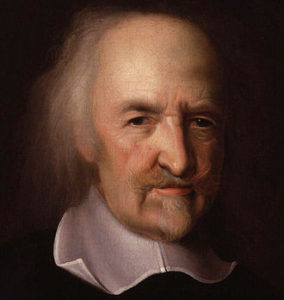 In the comments to the Progress post, a reader asked for clarification on what was so awful about Hobbes, and this was Ada’s response, which I am reposting as a post so that it doesn’t stay buried down there:
In the comments to the Progress post, a reader asked for clarification on what was so awful about Hobbes, and this was Ada’s response, which I am reposting as a post so that it doesn’t stay buried down there:
Ah, yes, that was probably to brief an abbreviation. To be clear, I LOVE Hobbes, and I both teach him and read him for pleasure all the time. In fact the title quote for the 3rd volume in “Terra Ignota” comes from Leviathan.
The Hobbes reference referred, not to my opinion of him or modern opinions on him, but contemporary opinions of him, how hated and feared he was by his peers in the mid-17th century. I’ll treat him more in the next iteration(s) of my skepticism series, but in brief Hobbes was a student of Bacon (he was actually Bacon’s amanuensis for a while) and used Bacon’s new techniques of observation and methodical reasoning with absolute mastery, BUT used them to come to conclusions that were absolutely terrifying to his peers, attacking the dignity of the human race, the foundations of government, the pillars of morality of his day, in ways whose true terror are hard for us to feel when we read Leviathan in retrospect, having accepted many of Hobbes’s ideas and being armored against the others by John Locke. But among his contemporaries, “The Beast of Malmsbury” as he was called, held an unmatched status as the intellectual terror of his day. In fact there are few thinkers ever in history who were so universally feared and hated–it’s only a slight exaggeration to say that for the two decades after the publication of Leviathan, the sole goal of western European philosophy was to find some way to refute Thomas Hobbes WITHOUT (here’s the tricky part) undermining Bacon. Because Bacon was light, hope, progress, the promise of a better future, and Hobbes was THE BEST wielder of Bacon’s techniques. So they couldn’t just DISMISS Hobbes without undermining Bacon, they had to find a way to take Hobbes on in his own terms and Bacon better than Hobbes did. It took 20 years and John Locke to achieve that, but in the meantime Hobbes so terrified his peers that they literally rewrote the laws of England more than once to extend censorship enough to silence Hobbes.
Also the man Just. Wouldn’t. Die. They wanted him dead and gone so they could forget him and move on but he lived to be 79, a constant reminder of the intellectual terror whose shadow had loomed so long over all of Europe. To give a sample of a contemporary articulation of the fear and amazement Hobbes caused in his peers, here is a satirical broadside published to celebrate his death:
My favorite verse from it is:
“Leviathan the Great is dead! But see
The small Behemoths of his progeny
Survive to battle all divinity!”
So I chose Hobbes as an example because he’s really the first “backfire” of Bacon, the first unexpected, unintended consequence of the new method. Hobbes’s book didn’t cause any atrocities, didn’t result in wars or massacres, but it did spread terror through the entire intellectual world, and was the first sniff of the scarier places that thought would go once Bacon’s call to examine EVERYTHING genuinely did examine everything… even things people did NOT want anyone to doubt. So while Hobbes is wonderful, from the perspective of his contemporaries he was the first warning sign that progress cannot be controlled, and that, while it will change parts of society we think are bad, it will change the parts we value too.
Hope that helps clear it up? I’ll discuss Hobbes more in later works.
October 29, 2016
Spot the Saint: More Dominicani
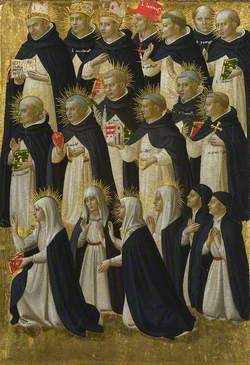
So many Dominican saints!
Hello, all. Deadlines, page proofs, preparing for tenure, and an extra heavy autumn teaching load with classrooms full of enthusiastic-and-therefore-time-consuming students have continued to keep me too busy for another skepticism essay, but here for your enjoyment (and with some help from the excellent Jo Walton who’s wonderful at hunting down saint pictures for me) is a new addition to my Spot the Saint Series, on how to recognize saints in art (click here to start the series from the beginning).
Today: more Dominicans.
As we all recall, the key to recognizing Dominicans in art is that they look like penguins. (Black mantle over white robe – black wings, white belly.) Dominicans are generally scholar monks, dedicated to the idea that the best way to reach Heaven is through knowledge, reason and study. They are associated with Spain, through their founder Saint Dominic, and were particularly prominent at the University of Paris. For many years the primary theological adviser to the pope (called the Master of the Sacred Palace) was always a Dominican, and when the Roman Inquisition started kicking into high gear in response to the printing press and the Reformation, the Dominicans were in charge of it. If you are familiar with the Jesuits, the Dominicans did a lot of the things the Jesuits would start to do in later periods.
In addition to Dominic, Thomas Aquinas and Peter Martyr, there are three other Dominican saints who show up frequently in Renaissance art, or at least in Florentine art. They are St. Antoninus, St Catherine and Siena, and St Vincent Ferrer.

Carlo Dolci, St Catherine of Siena
St. Catherine of Siena
Common attributes: Nun in Dominican robes, crown of thorns, lily
Occasional attributes: stigmata, book, model church, rose(s)
Patron saint of: Nurses, the sick, women tempted by lust, people mocked for their faith
Patron of places: Italy, Europe (yeah, she’s a big deal…)
Feast days: April 29-30
Most often depicted: Looking otherworldly & contemplative, marrying Christ, giving alms to the poor
Relics: body in Santa Maria sopra Miernva in Rome, head in Siena
Catherine of Siena (1347-1380) is one of the two patron saints of Italy, along with St Francis. In 1970 she was one of the first two woman ever to be named a Doctor of the Church (along with Saint Teresa of Ávila).
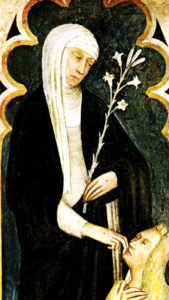 Catherine was born immediately before the Black Death, the twenty-third child in her family. It was a poor family, and she received no education, and did not learn to read until quite late. Growing, up she had every attribute of a classic un-learned female mystic. As a girl she had visions, and conversations with Christ, St Dominic, and the Virgin Mary. She refused to marry, but also refused to retreat into a cloistered life within a monastery, since she wanted to preach and travel, as male Dominicans did. At the age of twenty-one, she went through a mystic marriage with Christ, where he gave her his foreskin as a wedding ring — it was invisible to other people. Much like Francis of Assisi, she fasted almost constantly, and performed other extreme mortification of the flesh including drinking pus from the sick in hospitals. She also developed stigmata like Saint Francis, though some reports say they were invisible. Given how hard Catherine was on her body, it is no surprise that she only lived to be thirty-three.
Catherine was born immediately before the Black Death, the twenty-third child in her family. It was a poor family, and she received no education, and did not learn to read until quite late. Growing, up she had every attribute of a classic un-learned female mystic. As a girl she had visions, and conversations with Christ, St Dominic, and the Virgin Mary. She refused to marry, but also refused to retreat into a cloistered life within a monastery, since she wanted to preach and travel, as male Dominicans did. At the age of twenty-one, she went through a mystic marriage with Christ, where he gave her his foreskin as a wedding ring — it was invisible to other people. Much like Francis of Assisi, she fasted almost constantly, and performed other extreme mortification of the flesh including drinking pus from the sick in hospitals. She also developed stigmata like Saint Francis, though some reports say they were invisible. Given how hard Catherine was on her body, it is no surprise that she only lived to be thirty-three.
 What made Catherine an ecclesiastical superstar, differentiating her from scores of similar female mystics who were popular in their day but remained only minor local figures, was that in the later part of her (not very long) life she began to transition from a mystic to a theologian. Mysticism was one of few paths to respect and authority that were open to women within Medieval Christianity. A religious vocation for a woman would traditionally have led to a cloistered life (as Saint Francis prescribed for Claire of Assisi) but Catherine rejected this. She chose instead to join the Dominican Tertiaries, an order of lay nuns created for widows who wanted to have a spiritual life while continuing to live with their families to care for children and family fortunes. Catherine was the first non-widow to join the order (over much protest), and thus granted a unique new status as a nun without a convent, and a spiritual woman without a place or superior to anchor her. This let Catherine wander widely to do good works and preach. Her mysticism and reports of visions, and her frequent transports into dramatic ecstasy, earned her great fame, so people crowded to see her wherever she went, even when her words began to sound less like mysticism and more like serious scholarly theology. Her ideas were very different and substantially more penetrable than the learned, Thomist, Aristotelian content of many sermons. She was taught to read by the Tertiaries when she became one, and the Dominicans assigned a scribe to follow her around and write down everything she said. At first this simply produced accounts of her ecstatic visions, but over time she began to dictate more polished and serious works, and letters to people in many corners of politics. She even served as Florence’s ambassador to the Avignon papacy for a time. When she turned thirty, she learned to write, and helped to edit and polish her corpus, which includes nearly four hundred letters, a dialogue, and some prayers. This constituted the first substantial body of theological writing by a woman of the Renaissance (though there had certainly been Medieval female theologians such as Hildegard of Bingen), and the first written theology ever by a woman from such a poor background who would not normally have had access to education.
What made Catherine an ecclesiastical superstar, differentiating her from scores of similar female mystics who were popular in their day but remained only minor local figures, was that in the later part of her (not very long) life she began to transition from a mystic to a theologian. Mysticism was one of few paths to respect and authority that were open to women within Medieval Christianity. A religious vocation for a woman would traditionally have led to a cloistered life (as Saint Francis prescribed for Claire of Assisi) but Catherine rejected this. She chose instead to join the Dominican Tertiaries, an order of lay nuns created for widows who wanted to have a spiritual life while continuing to live with their families to care for children and family fortunes. Catherine was the first non-widow to join the order (over much protest), and thus granted a unique new status as a nun without a convent, and a spiritual woman without a place or superior to anchor her. This let Catherine wander widely to do good works and preach. Her mysticism and reports of visions, and her frequent transports into dramatic ecstasy, earned her great fame, so people crowded to see her wherever she went, even when her words began to sound less like mysticism and more like serious scholarly theology. Her ideas were very different and substantially more penetrable than the learned, Thomist, Aristotelian content of many sermons. She was taught to read by the Tertiaries when she became one, and the Dominicans assigned a scribe to follow her around and write down everything she said. At first this simply produced accounts of her ecstatic visions, but over time she began to dictate more polished and serious works, and letters to people in many corners of politics. She even served as Florence’s ambassador to the Avignon papacy for a time. When she turned thirty, she learned to write, and helped to edit and polish her corpus, which includes nearly four hundred letters, a dialogue, and some prayers. This constituted the first substantial body of theological writing by a woman of the Renaissance (though there had certainly been Medieval female theologians such as Hildegard of Bingen), and the first written theology ever by a woman from such a poor background who would not normally have had access to education.

Catherine of Siena’s mystic marriage with Christ
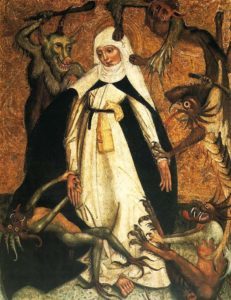
Catherine resists temptation by demons, a very classic thing for both mystics AND male monk saints.
Before this starts to sound too progressive, Catherine of Siena never stopped being a traditional mystic, having visions, ecstasy etc., and it was absolutely because of her status as a mystic that everyone (the Dominicans, Florence, Rome) started to care about her. Mysticism was a traditional path which Catherine never left, though she did add something new to it, which women generally had not done before, through her preaching and written works. It is really in the posthumous reception of her work that the transition becomes more significant. Over the centuries since Catherine’s life, people in the Catholic Church and in the West in general have come to care more and more about education and especially education for women, and less and less about mysticism. Society’s taste in saints has changed, and as it changed the many dozens of female mystics came to fit it less and less, while Catherine-the-groundbreaking-theologian came to fit it more and more. Hence the expansion of her cult over the past centuries while many other saints’ cults have diminished, and her elevation to the prestigious positions of Patroness of Europe, Patroness of Italy alongside Francis whose life hers modeled so much, and in 1970 Doctor of the Church.
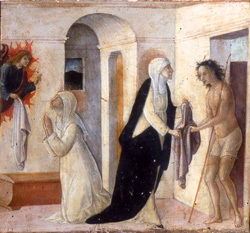
Piero della Francesca, St Catherine’s Visions of Christ
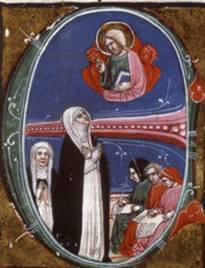
Catherine having a vision, while at the right her scribes write down what she says.
Catherine died in Rome at the age of thirty-three, after a stroke probably caused by what would now be called anorexia. Her body was immediately put on display in the Dominican headquarters church of Santa Maria sopra Minerva, and began to be venerated there even though she would not be canonized for another 80 years.
This kind of sudden veneration of a non-canonized body was really not allowed, and happened a lot in more peripheral towns where Rome had little control, so the fact that it happened in Rome itself was quite remarkable.

Catherine’s tomb has been moved to the front of Santa Maria sopra Minerva; here you see it with the tombs of the Medici popes Leo X & Clement VII behind it.
Her head was stolen almost immediately, and smuggled back to Siena, where it was encased in a bronze bust, which was honored in a parade which Catherine’s (very tired) mother attended.
Catherine was canonized in 1461 by Pius II, who was himself from Siena, so he had strong personal reasons to encourage the veneration of this great celebrity who would bring honor and pilgrims to his hometown. He was also a scholar and theologian himself, so his enthusiasm for Catherine was certainly motivated by sincerity as well as hometown pride.
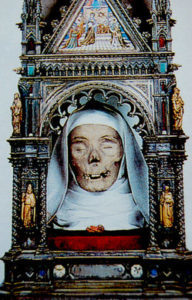 Siena’s excitement about Catherine is overwhelming to this day.
Siena’s excitement about Catherine is overwhelming to this day.
One time I was visiting Siena to see a manuscript, and got to chatting with the taxi driver, who told me I should visit Catherine’s head while I was in town. I told him I had just visited her body in Rome. He became very quiet for a moment, and then said very seriously, “The head is the important part.”
In art Catherine can most easily be spotted as a female Dominican, sometimes balancing a female Franciscan, who will be St Clare. (If there’s a female Benedictine, it’s usually St Scholastica.) She often has a lily, representing her chastity and connecting her to Saint Dominic who also holds one. In later art, 17th century and on, she pretty consistently has a crown of thorns. In some early art she was depicted with stigmata, but the Franciscans protested, and got the Church to rule that only Francis may be depicted with stigmata, so any images of Catherine with stigmata are technically heretical. Sometimes Catherine wears a starry headscarf (especially in paintings by Fra Angelico), which can lead her to be confused with the Virgin Mary. There are paintings of her visions, and of her mystical marriage. She is sometimes depicted holding a rose, reflecting a miracle that happened when her head was being smuggled out of Rome to Siena, and guards inspected the mysterious package as the thieves were leaving the gates of Rome, but when they looked in the bag they just saw a pile of roses instead of the head, so the head made it safely to Siena.
IMPORTANT: DO NOT confuse CATHERINE OF SIENA with CATHERINE OF ALEXANDRIA.
They have a lot in common, and are often depicted together, so the names can make it easy to mix them up. Both are virgin saints, and both had a mystic marriage with Christ, but Catherine of Alexandria is depicted having a mystic marriage with the INFANT Christ, while Catherine of Siena is usually depicted as marrying the ADULT Christ. In addition, Catherine of Alexandria has a wheel, a crown, a martyr’s palm, and Roman clothes, while Catherine of Siena has a nun’s habit, and a lily, and if she has a crown it’s thorns, rather than a queenly crown. Here they are together:
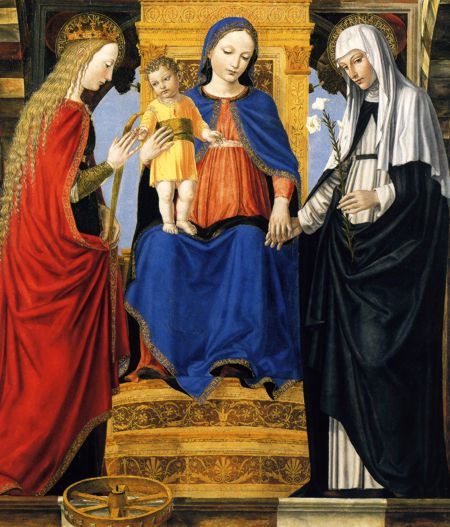
Though before you get too comfortable, they do sometimes reverse which Catherine marries the adult Christ and which marries the baby:
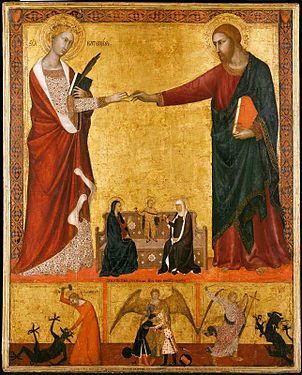
Here Catherine of Alexandria (with crown and martyr’s palm) marries the adult Christ, while small in the middle Catherine of Siena, in her nun’s outfit, interacts with the baby. And at the bottom left a demon is getting whacked with a hammer.

Note the many prominent Dominicans around Catherine of Siena here. The man in the bottom right without a halo, with the conspicuously detailed face, is a portrait of the man who commissioned the painting.
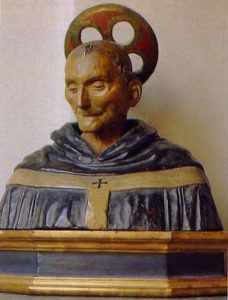 St. Antoninus of Florence
St. Antoninus of FlorenceCommon attributes: Dominican robe with white T-shaped sash with crosses on it across his shoulders (indicating that he is a bishop)
Occasional attributes: Bishop’s hat, bishop’s robes over Dominican habit
Patron saint of: Florentine Dominicans
Patron of places: The town of Moncalvo near Turin, + Florence
Feast days: May 2nd and 10th
Most often depicted: In Florence
Relics: Florence, San Marco
St Antoninus (1389-1459) is Florence’s own saint, the first Florentine to actually be made a saint since Saint Zenobius (d. 417 AD) which is a long time for Florence to wait, while their neighbors kept accumulating more and more: Saints Francis & Claire of Assisi, Saint Peter Martyr of Verona, Saint Antony of Padua, Saint Dominic buried in Bologna, Saints Bernardino and Catherine of Siena, etc.
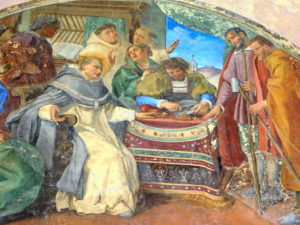
Antoninus, from the fresco cycle in San Marco
Antoninus was the son of a Florentine notary. In 1405 he became a Dominican and joined a monastery in the small hill town of Fiesole, just outside Florence. At that time, there was only one large Dominican monastery in Florence, the one attached to Santa Maria Novella (now by the train station). The Dominican brotherhood at Santa Maria Novella had been founded in 1221 to celebrate a peace settlement between the Guelphs & Ghibellines (which lasted all of 30 seconds before civil war resumed…), but it was a somewhat peripheral location Franciscans at Santa Croce and the Benedictins at the Badia. Thus Antoninus aspired to found a larger Dominican congregation, somewhere within the heart of the city. Even though monastic life is supposed to be cloistered and separate, a central location would bring prestige and influence. His attention focused on a small 12th century monastery in the north end of the city, built originally for Vallombrosan monks but occupied at the time by a small community of Benedictines, who were content to sell the property for the right price.
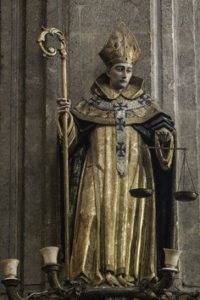
Antoninus dressed as a bishop, but still with the white sash with crosses on it, and the black over-cape of a Dominican
To muster the funds to buy the property and replace the cramped 12th century complex with a grand Renaissance one, Antoninus turned to his good friend Cosimo de Medici, who, in the first decades of the 1400s, was in the process of advancing from simply having a lot of money to controlling all of Florence with his money. Cosimo was very willing to spend on public works projects in general–both because it won the good will of the people and because he was worried about going to Hell for usury–and he was especially happy to spend on humanist and scholarly projects such as libraries, and setting up a community of scholar-monks to use said libraries. Antoninus extracted a lot of money from Cosimo over the years, not just for rebuilding and decorating San Marco, but for feeding and clothing the poor. Cosimo joked that it didn’t matter how much he gave, he could never close the books, he’d always be in God’s debt.
When Cosimo de’ Medici rebuilt the monastery for the Dominicans in 1433, Antoninus became the first prior of San Marco, and then became Archbishop of Florence in 1446. All archbishops of Florence in this period went through a mystical marriage with the Abbess of S. Pier Maggiore, which included a full wedding ceremony in the Duomo and spending a night in a special bed in the convent. Oddly enough, this incident, which is on record, does not appear in the great fresco cycle of Saint Antoninus’s life and miracles that decorates one of the courtyards in San Marco.
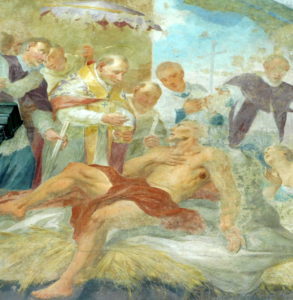
Antoninus, dressed as a bishop, with his umbrella, with some Dominican brothers, giving last rites to a Black Death sufferer
As well as feeding the poor, Antoninus went among them to give them last rites when they had the plague, which was a big deal. So many priests had refused to put their own lives at risk doing this in the Great Plague of 1348 that the pope at the time (Clement VI, one of the Avignon popes) granted an indulgence to everyone who died of it, meaning they’d go straight to heaven, which was probably the largest indulgence ever granted, as that plague killed a third of Europe.

This is an enlargement of the armpit of the plague victim, showing the “bubo” or swollen lymph node which gave the “bubonic” form of the plague its name.
While we tend to think of the Black Death sweeping through in 1348 and then leaving again, it was actually endemic in Europe until the 18th century, and fresh outbreaks were frequent in Italy throughout the Renaissance. There was a bad outbreak in Antoninus’s time, not as deadly since everyone alive in the 1420s was the child of somone who had resisted the 1348 outbreak so many had stronger immune systems (yay natural selection), but most people including priests still preferred not to have contact with the sufferers, so his ministration was exceptional.
Antoninus disapproved of gambling, cheating and usury. He didn’t have a dramatic life or dramatic miracles, but he was famous for living a simple and austere life even after he became famous and influential. He was also a great scholar and advocate of Church reform (which made his works popular during the Reformation and Counterreformation), not to mention incredibly popular with ordinary Florentines. As soon as Pope Leo X (Giovanni di Lorenzo de Medici i.e. Cosimo de Medici’s great grandson) was firmly seated on the Throne of St. Peter, he began the process of pushing for Antoninus’s canonization, but it was not completed until the (very brief) reign of Leo’s successor Adrian VI.

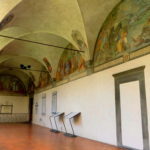 There’s an entire fresco-cycle running around the top of the first courtyard of San Marco devoted to Antoninus’s life of genuinely impressive public works and fairly unimpressive miracles. The most fun miracle is the time they had lost the key to a chest, and then he had a fish for dinner and the key miraculously turned up in the fish. He also performed some exciting exorcisms.
There’s an entire fresco-cycle running around the top of the first courtyard of San Marco devoted to Antoninus’s life of genuinely impressive public works and fairly unimpressive miracles. The most fun miracle is the time they had lost the key to a chest, and then he had a fish for dinner and the key miraculously turned up in the fish. He also performed some exciting exorcisms.
You very seldom see Saint Antoninus represented outside Florence — or even very far from San Marco, so he is usually recognizable by context. Are you in Florence, or looking at Florentine art? If so, that Dominican with a bishop’s white T-shaped sash is pretty certainly Antoninus. In general he is differentiated from other major Dominican saints by the white sash.
St. Vincent Ferrer
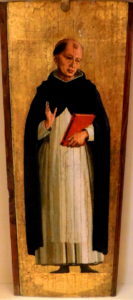
St Vincent Ferrer by Fra Angelico
Common attributes: Dominican robes, flame.
Occasional attributes: Book, wings or winged cherubs, trumpet.
Patron saint of: plumbers, construction workers
Patron of places: Vannes (in Brittany), Valencia somewhat
Feast days: April 5
Most often depicted: With other Dominicans
Relics: Vannes Cathedral
St Vincent Ferrer (1350-1419) was born in Valencia in Spain. He became a Dominican very young, and spent his life travelling around Europe preaching and converting Cathars and Jews. He was canonized by Pope Calixtus III (Alfons de Borja i.e. Rodrigo Borgia’s uncle), who himself came from Valencia — yes another hometown canonization.
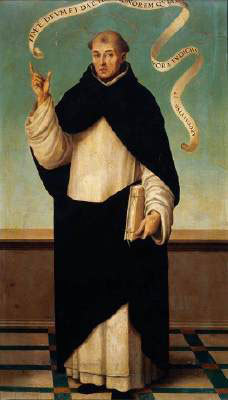 Vincent Ferrer was a contemporary of Catherine of Siena, and the two of them ended up on opposite sides of the Western Schism. For those who need a refresher, in 1305, after a big fight between Pope Boniface VIII and the King of France over who got to appoint French bishops, a rough and frightened papal conclave elected a French pope, Clement V, who stayed in Avignon, and for the next several popes the papacy remained in Avignon, under the control of France. This ended when Pope Gregory XI returned from Avignon to Rome in 1377 and then died in 1378, but upon his death Rome elected one new pope (Urban VI) and Avignon elected another (Clement VII), and when these died yet more rival popes were appointed, until the whole mess was finally solved by the Council of Constance in 1416 (a long time to wait to know who’s pope!) During the controversy, Vincent Ferrer was a strong and loyal supporter of the Avignon popes (note that Avignon is quite close to Valencia), while Catherine of Siena supported the Roman popes, and was sent to argue for them as Florence’s ambassador (unsuccessfully but her work probably helped set the stage for later embassies). Thus the fact that both Vincent and Catherine were eventually canonized shows how spread out and complex the Dominican order was, and how it was often part of many different Church movements at once, even contradictory ones: pro-Spanish/French v. pro-Italian, pro-scholarly v. pro-mystic, and of course how, later on, it could at the same time be a great promoter of intellectual study and innovation and also run the Inquisition.
Vincent Ferrer was a contemporary of Catherine of Siena, and the two of them ended up on opposite sides of the Western Schism. For those who need a refresher, in 1305, after a big fight between Pope Boniface VIII and the King of France over who got to appoint French bishops, a rough and frightened papal conclave elected a French pope, Clement V, who stayed in Avignon, and for the next several popes the papacy remained in Avignon, under the control of France. This ended when Pope Gregory XI returned from Avignon to Rome in 1377 and then died in 1378, but upon his death Rome elected one new pope (Urban VI) and Avignon elected another (Clement VII), and when these died yet more rival popes were appointed, until the whole mess was finally solved by the Council of Constance in 1416 (a long time to wait to know who’s pope!) During the controversy, Vincent Ferrer was a strong and loyal supporter of the Avignon popes (note that Avignon is quite close to Valencia), while Catherine of Siena supported the Roman popes, and was sent to argue for them as Florence’s ambassador (unsuccessfully but her work probably helped set the stage for later embassies). Thus the fact that both Vincent and Catherine were eventually canonized shows how spread out and complex the Dominican order was, and how it was often part of many different Church movements at once, even contradictory ones: pro-Spanish/French v. pro-Italian, pro-scholarly v. pro-mystic, and of course how, later on, it could at the same time be a great promoter of intellectual study and innovation and also run the Inquisition.
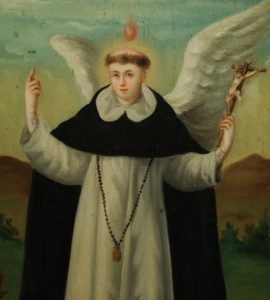 In art, at least outside Valencia and Vannes, Vinecnt Ferrer is generally just an extra Dominican. His most common attribute is a tongue of flame, either on his head or in his hand, though Antony of Padua sometimes has the same, as do apostles and evangelists, so make sure to look for the penguin robes before reaching for Vincent Ferrer as an identification. If Dominic and Thomas Aquinas and Peter Martyr are accounted for and there’s an extra one, even without attributes, it usually turns out to be Vinecnt Ferrer. So if you’re looking at a painting and there’s another male penguin monk who doesn’t he have a lily and a star, isn’t chubby, doesn’t have the ability to interpret Aristotle blazing from his chest like the son, and doesn’t he have a knife in his head or gore dripping down his shoulders, then he’s probably Vincent Ferrer. There’s a slight possibility he may be St Raymond of Penafort or St Hyacinth of Poland, higher if the picture is from Spain or Poland. Albertus Magnus is another possibility, but he is depicted rarely enough that he generally seems to get labelled.
In art, at least outside Valencia and Vannes, Vinecnt Ferrer is generally just an extra Dominican. His most common attribute is a tongue of flame, either on his head or in his hand, though Antony of Padua sometimes has the same, as do apostles and evangelists, so make sure to look for the penguin robes before reaching for Vincent Ferrer as an identification. If Dominic and Thomas Aquinas and Peter Martyr are accounted for and there’s an extra one, even without attributes, it usually turns out to be Vinecnt Ferrer. So if you’re looking at a painting and there’s another male penguin monk who doesn’t he have a lily and a star, isn’t chubby, doesn’t have the ability to interpret Aristotle blazing from his chest like the son, and doesn’t he have a knife in his head or gore dripping down his shoulders, then he’s probably Vincent Ferrer. There’s a slight possibility he may be St Raymond of Penafort or St Hyacinth of Poland, higher if the picture is from Spain or Poland. Albertus Magnus is another possibility, but he is depicted rarely enough that he generally seems to get labelled.

Spot the Saint Mini-Quiz
And now, for the first time in a long time, your spot-the-saint review quiz. If you review earlier Spot the Saint posts, you should be able to identify all these figures except the man all the way on the right, with a harp and a crown (though those of you with biblical knowledge can hopefully recognize him. Hint: he’s not a saint):

June 21, 2016
Four Updates
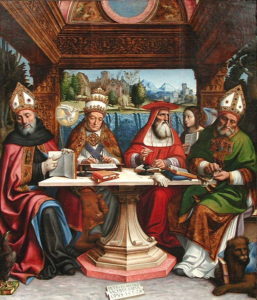
Carlo Signorelli, The Four Doctors of the Church, clearly pictured here in a train designed by the same people who designed the luxury elevator in the Vatican
One day (soon! Soon I hope!) Ada will have time to make the more substantive posts here we’d all prefer, but for now I’m doing another brief update for her.
Some things come in fours — elements, doctors of the church, virtues, and this post.
First, fire, St Augustine, and fortitude: an intensive review of Too Like the Lightning by the erudite John Clute at Strange Horizons.
The moderately peculiar title may be intended to illuminate an inchoate suspicion that this tale may be all about how lightning precedes comeuppance (as always) but stops short of the thunder: Too Like the Lightning seems to be how two hundred years of an immensely complex and constantly negotiated peace are about to explode in an immense light show, leaving tatters, but does not tell us anything about the thump and consequence of landing. Its large loquacious cast—each member of which is significantly involved in maintaining a utopia responsible for the weal of ten billion souls—seems by the end of this volume to be running out of words: illustrated men and women about to char. You can almost feel the electricity.
This isn’t so much a review as a long essay. There have also been reviews on NPR, in the Chicago Tribune, and all over, as well as lots of interviews, including Scientific American. There are long lists of guest posts, interviews, and interesting reviews here.

Giolitti, some of the best gelato in Rome
Second water, St Gregory, and temperance: The Gelato Atlas has been updated to include not only Gelateria della Passera, the great new place Ada spotted from fifteen feet away when it wasn’t even open — so exciting to have good gelato in the Oltrarno! — but gelato other people have found in Finland, Rome, the USA and other exotic locations.
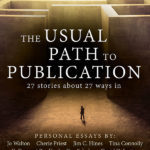 Third, air, St Ambrose, and justice: the book The Usual Path to Publication has just been released, and Ada has a piece in it about how Too Like the Lightning came to be published. This project arose out of a question at a convention when somebody asked a panel about “the usual path to publication” and the title reflects the answer that there isn’t one, because everyone’s experience is different. This makes it fascinating to read, and especially for aspiring writers. E-books are available from Book View Café: http://bookviewcafe.com/bookstore/book/the-usual-path-to-publication/ Amazon: http://amzn.com/1611386020, B&N: http://www.barnesandnoble.com/w/the-usual-path-to-publication-shannon-page/1123876756?ean=2940158509636 and for Kobo: https://store.kobobooks.com/en-us/ebook/the-usual-path-to-publication. It’s a physical book too, available where all good books are sold. ( For example at Barnes & Noble and Amazon) (Ada says: I’m extremely proud of this essay, one of my very best explorations of the art of the essay; highly recommended!)
Third, air, St Ambrose, and justice: the book The Usual Path to Publication has just been released, and Ada has a piece in it about how Too Like the Lightning came to be published. This project arose out of a question at a convention when somebody asked a panel about “the usual path to publication” and the title reflects the answer that there isn’t one, because everyone’s experience is different. This makes it fascinating to read, and especially for aspiring writers. E-books are available from Book View Café: http://bookviewcafe.com/bookstore/book/the-usual-path-to-publication/ Amazon: http://amzn.com/1611386020, B&N: http://www.barnesandnoble.com/w/the-usual-path-to-publication-shannon-page/1123876756?ean=2940158509636 and for Kobo: https://store.kobobooks.com/en-us/ebook/the-usual-path-to-publication. It’s a physical book too, available where all good books are sold. ( For example at Barnes & Noble and Amazon) (Ada says: I’m extremely proud of this essay, one of my very best explorations of the art of the essay; highly recommended!)
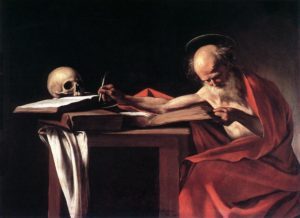 Fourth, earth, St Jerome, and patience (thank you for yours!) — after Readercon, Ada will be doing three events in bookstores in the north-eastern US. She’ll be reading from Too Like the Lightning, and I’ll be there too, reading from my new novel Necessity. We’ll also be discussing the books, answering questions, and signing books.
Fourth, earth, St Jerome, and patience (thank you for yours!) — after Readercon, Ada will be doing three events in bookstores in the north-eastern US. She’ll be reading from Too Like the Lightning, and I’ll be there too, reading from my new novel Necessity. We’ll also be discussing the books, answering questions, and signing books.
11th July 2016 7pm. River Run Books, Portsmouth, New Hampshire USA.
12th July 2016 7pm. Harvard Bookstore, Cambridge, Mass USA.
13th July 2016 7pm. The Word Bookstore, Brooklyn, USA.
And here’s hoping the fifth element–aether, pseudo-Dionysius the Areopagite, Ada actually writing a full essay here–will follow in the not-to-distant future.
June 1, 2016
San Marco: The Dominican Monastery at the Heart of Renaissance Florence
Off to Italy again. This seems like a good time to share a link to a video of an illustrated talk Ada gave at the Lumen Christi institute in Chicago in February. It’s a fascinating overview of the place of San Marco in Florence, with lots of excellent pictures. It’s like an audio version of an Ex Urbe post, with Fra Angelico, the meaning of blue, the Magi, the Medici, Savonarola, confraternities, and the complexities of Renaissance religious and artistic patronage.
And here’s one of the pictures mentioned but not shown in the presentation, a nine panel illustration by Filippo Dolcaiati “The History of Antonio Rinaldeschi.” It depicts the real historical fate of Rinaldeschi, who became drunk while gambling and threw manure at an icon of the Virgin Mary. A fascinating incident for demonstrating the functions of confraternities, and for demonstrating how seriously the people of Florence took the protection offered by saints and icons.

May 11, 2016
Day After the Book Comes Out Link Round-up
The long wait is over at last, and Too Like the Lightning came out yesterday! This is just a simple little links round-up post by Jo. Too Like the Lightning is available right now as a hardback book and as an e-book in multiple formats, and the audiobook was also just released — and here’s the audiobook cover, which makes me think we’re very lucky indeed with the main cover.
First, unrelated to the book, on Lawrence Schoen’s Eating Authors Ada has an essay about “Her Favorite Ever Meal” which, naturally, was in Florence…
Meanwhile Ada’s been guest blogging about it all over:
Ada's Guest Blog PostsWhatever (John Scalzi's Blog): The Big Idea, Too Like the LightningBiblioSanctum: In Terra Ignota, Diaspora Becomes Nations Without BordersTor/Forge Blog: World Building Like a Historian (Terra Ignota)SF Signal: Middle Future Science Fiction (Terra Ignota)Locus Online: World Building and Change in Terra IgnotaMy Bookish Ways: Q&A with Ada Palmer about Too Like the Lightning
In addition, there have been some really excellent reviews that recognise what an astonishing and game changing book it is:
Reviews of Too Like the LightningBarnes and Noble: The Future is Past in Ada Palmer's Too Like the LightningBoingBoing: Too Like the Lightning: intricate worldbuilding, brilliant speculation, gripping storytellingCrooked Timber: What's So Brilliant about Ada Palmer's Too Like the LightningGeekly Inc: Not the Best of All Possible Worlds But CloseJo Walton on Tor.com: A Future Worth HavingNPR Review: Science Fiction and Philosophy Collide in Astonishing Lightning (Too Like the Lightning)Romantic Times: Review of Too Like the Lightning (SF Revu. "one of the truly great works of speculative literature"

